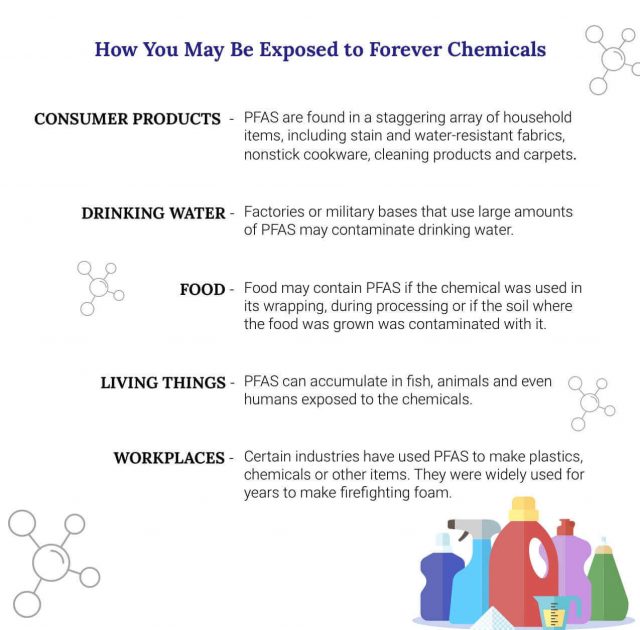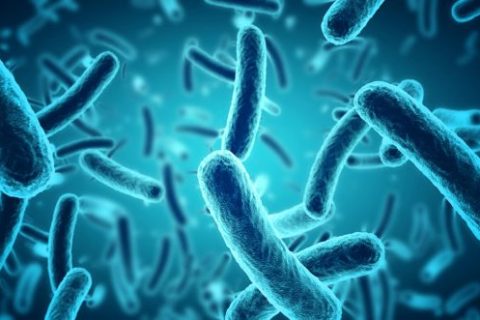PFAS
PFAS, or per- and polyfluoroalkyl substances, are a group of widely-used, man-made chemicals that are likely all around you. They are sometimes called “forever chemicals” because they don’t break down, and they can accumulate in both the environment and the human body. Studies have found that PFAS may cause serious health problems, including cancer.

PFAS include around 5,000 chemicals. They have been produced since the 1940s, but their health and environmental risks only gained widespread attention after the chemicals were found in drinking water in 2001. Nearly everyone has come in contact with these forever chemicals through water, food or consumer products.
The two most common and controversial PFAS are no longer made in the United States. But products made with or containing them may still be imported.
And because they take an incredibly long time to break down and have been so widely used, scientists continue to find these older PFAS in rivers, lakes and many drinking water supplies in the United States. They are so prevalent that a researcher told NPR in 2019 that just about everyone in America has some of these chemicals in their blood.
- PFAS include roughly 5,000 different chemicals.
- They are found in consumer goods, food and drinking water.
- More than 16 million Americans drink water contaminated with PFAS from military or industrial sites.
- A 2015 study estimated that PFAS are present in the blood of 97 percent of Americans.
- As PFAS use has declined, so have levels of it in blood.
What Are the Health Risks?
Some studies have linked PFAS exposure to an increased risk of certain cancers. But there is surprisingly little research into the health effects of these chemicals, which have been around for more than 70 years.
A large study of people exposed to one particular PFAS in the Ohio River Valley found a probable link between the chemical C8 and several diseases. Other studies have also associated PFAS with health problems.
- Effects on growth, learning and behavior of infants and children
- Effects on the immune system
- Increased cholesterol levels
- Interference with natural hormones
- Kidney cancer
- Pregnancy-induced hypertension
- Reduced chance of pregnancy
- Testicular cancer
- Thyroid disease
- Ulcerative colitis
Pregnant or breastfeeding women who have PFAS in their blood can transfer the chemical to their babies. But the current research shows that the benefits of breastfeeding outweigh the risks of PFAS effects on infants, according to the Centers for Disease Control and Prevention.
For the most part, companies don’t have to prove their chemicals are safe before they start selling them. The U.S. Environmental Protection Agency is charged with determining whether a chemical is dangerous, but the agency usually doesn’t even start looking at a chemical’s safety until after reports of widespread health problems.
Where Are PFAS Found?
PFAS may be found all around you. You likely have several products containing PFAS in your house. They have been found polluting soil and have been a major cause of water contamination throughout the country. As many as 97 percent of people living in the United States may have PFAS in their bloodstreams, according to the U.S. National Health and Nutrition Examination Survey.

Is There a Safe Level of Exposure?
Regulators in the United States still have not established a legal safe limit for exposure to PFAS. The U.S. Environmental Protection Agency announced in February 2019 that it was finally starting the process.
“We are moving forward with several important actions, including the maximum contaminant level process, that will help affected communities better monitor, detect, and address PFAS,” EPA Administrator Andrew Wheeler stated on the agency’s website.
The EPA did lower a nonbinding limit for some PFAS in 2016. That was set at 70 parts per trillion. To get an idea of how small that amount is, think of it as 70 grains of sand in an Olympic-sized swimming pool or as traveling just 35 feet on a 93 million mile trip to the sun.
But the U.S. Centers for Disease Control and Prevention has warned that PFAS can cause health problems in far smaller amounts.
Drinking Water Contamination
There has been increased concern of PFAS contamination in drinking water since the EPA required water systems to test for 10 of the chemicals. The testing, conducted between 2013 and 2015, found that about 1 in every 100 water systems in the country tested above the nonbinding limit for at least one PFAS on the EPA’s list.
Contamination at Factory Sites and Military Bases
Most drinking water contamination happens near factories that used PFAS in manufacturing or military bases, refineries or other places where firefighting foam was used.
The Environmental Working Group found that the drinking water of 16 million Americans in 33 states is contaminated with at least one PFAS. But the group based those numbers on tests at just 5,000 water utilities. Based on other data the group has examined, it estimates the total number of people affected could be as high as 110 million.
States, Communities and Individuals Have Filed Lawsuits over Contamination
States and cities have filed lawsuits against manufacturers or companies that used PFAS.
The state of Minnesota reached an $850 million settlement with 3M in 2018 as a result of the company having legally dumped PFAS in landfills near suburbs east of Minneapolis and St. Paul until the 1970s. At the time of the settlement, 3M faced at least 24 other lawsuits over PFAS contamination.
In 2017, DuPont and Chemours Co. paid $671 million to settle 3,550 personal injury claims over PFAS pollution. People had sued after PFAS from a Teflon plant in Parkersburg, West Virginia, polluted drinking water supplies.
In June 2023, 3M agreed to pay at least $10.3 billion and up to $12.5 billion to settle lawsuits for contamination of many U.S. public drinking water systems with PFAS used in many consumer products and firefighting foam. Also in the same month, DuPont de Nemours Inc., The Chemours Co. and Corteva Inc. agreed to a $1.18 billion settlement fund to compensate water providers in various states for PFAS contamination.
Consumer Products Containing PFAS
Their nonstick and water-resistant properties have made PFAS a go-to choice for products from food wrappers to firefighting foam. They are found in or used to make countless consumer goods that require durability and resistance to oil and water.
- Camping tents
- Certain types of dental floss
- Nonstick pans and utensils
- Pizza boxes
- Popcorn bags
- Sandwich wrappers
- Shoes and other leather products
- Some cosmetics
- Stain treatments for furniture and carpet
- Water and stain resistant clothing
Does Teflon Contain PFAS?
Teflon is the registered trademark and brand name of DuPont’s nonstick material commonly found in cookware. It is sometimes associated with worries about PFAS.
Teflon and other nonstick cookware is “not a significant source” of PFAS exposure, according to the American Cancer Society. The society also says Teflon is not suspected of causing cancer and that there are no known health risks of using Teflon-coated cookware.
Teflon’s chemical name is polytetrafluorethylene, or PTFE. It is not a PFAS.
But a PFAS called perfluorooctanoic acid was used to make Teflon until DuPont switched to another chemical in 2013. The PFAS burned off during the manufacturing process but may have left small traces behind.
Some environmental groups or regulators recommend tossing out nonstick pans made before 2013 or avoiding them all together.
How to Reduce Your Exposure
The most serious exposure may come from contaminated drinking water. You can check an interactive map from Northeastern University and the Environmental Working Group to see if water systems in your community have shown contamination.
You can also limit your exposure to everyday items that may contain or be made with PFAS by choosing alternatives whenever possible.
- Avoid processed and fast foods which may be packaged in PFAS wrappers.
- Be wary of stain-repellant clothes and treatment for furniture.
- Check labels on personal care products. Avoid those with “PTFE” or “Fluoro” ingredients.
- Skip microwave popcorn that can have PFAS packaging.
- Substitute stainless steel or cast-iron pans for nonstick cookware.
Blood tests can determine if you have been exposed to PFAS, but they cannot show if your medical condition is related to PFAS exposure. Tests also cannot predict if you will develop any health condition because you were exposed.
The U.S. Centers for Disease Control and Prevention has a fact sheet to help you talk to your doctor if you are concerned about your PFAS exposure.
26 Cited Research Articles
Consumernotice.org adheres to the highest ethical standards for content production and references only credible sources of information, including government reports, interviews with experts, highly regarded nonprofit organizations, peer-reviewed journals, court records and academic organizations. You can learn more about our dedication to relevance, accuracy and transparency by reading our editorial policy.
- Agency for Toxic Substances and Disease Registry. (n.d.). Talking to Your Doctor About Exposure to PFAS. Retrieved from https://www.atsdr.cdc.gov/pfas/docs/Talking_to_Doctor.pdf
- American Cancer Society. (2016, January 5). Teflon and Perfluorooctanoic Acid (PFOA). Retrieved from https://www.cancer.org/cancer/cancer-causes/teflon-and-perfluorooctanoic-acid-pfoa.html
- Boronow, K.E. (2019, January 8). Serum Concentrations of PFASs and Exposure-Related Behaviors in African American and Non-Hispanic White Women. Retrieved from https://www.nature.com/articles/s41370-018-0109-y
- C8 Science Panel. (2017, January 4). The Science Panel Website. Retrieved from http://www.c8sciencepanel.org/
- Dunbar, E. and Marohn, K. (2018, February 20). Minnesota Settles Water Pollution Suit Against 3M for $850 Million. Retrieved from https://www.mprnews.org/story/2018/02/20/3m-pfc-groundwater-pollution-trial-announcement
- Environmental Working Group. (n.d.). EWG’S Guide To Avoiding PFAS Chemicals. Retrieved from https://static.ewg.org/ewg-tip-sheets/EWG-AvoidingPFCs.pdf
- Environmental Working Group. (n.d.). “Forever Chemical”: Teflon, Scotchgard and the PFAS Contamination Crisis. Retrieved from https://www.ewg.org/key-issues/toxics/nonstick-chemicals
- Hersher, R. (2019, April 22). Scientists Dig Into Hard Questions About the Fluorinated Pollutants Known as PFAS. Retrieved from https://www.npr.org/sections/health-shots/2019/04/22/708863848/scientists-dig-into-hard-questions-about-the-fluorinated-pollutants-known-as-pfa
- Hu, X.C., et al. (2016, August 9). Detection of Poly- and Perfluoroalkyl Substances (PFASs) in U.S. Drinking Water Linked to Industrial Sites, Military Fire Training Areas, and Wastewater Treatment Plants. Retrieved from https://pubs.acs.org/doi/abs/10.1021/acs.estlett.6b00260
- Hurdle, J., Phillips, S. and Brady, J. (2019, February 14). EPA Says It Plans to Limit Toxic PFAS Chemicals, but not Soon Enough for Critics. Retrieved from https://www.npr.org/2019/02/14/694660716/epa-says-it-will-regulate-toxic-pfas-chemicals-but-not-soon-enough-for-critics
- Knickmeyer, E. and Flesher, J. (2019, February 15). EPA Readies “Forever Chemical” PFA Safety Plan Amid Calls for Tougher Action. Retrieved from https://www.insurancejournal.com/news/national/2019/02/15/518002.htm#
- Loria, K. (2019, April 8). Should You Be Concerned About PFAS Chemicals? Retrieved from https://www.consumerreports.org/toxic-chemicals-substances/pfas-chemicals-should-you-be-concerned/
- Nair, A.S. (2017, February 13). DuPont Settles Lawsuits Over Leak of Chemical Used to Make Teflon. Reuters. Retrieved from https://www.reuters.com/article/us-du-pont-lawsuit-west-virginia/dupont-settles-lawsuits-over-leak-of-chemical-used-to-make-teflon-idUSKBN15S18U
- Scialla, M. (2016, August 12). What Are PFAS, the Toxic Chemicals Being Found in Drinking Water? Retrieved from https://www.pbs.org/newshour/science/pfas-toxic-chemical-millions-peoples-drinking-water
- Scialla, M. (2016, June 22). It Could Take Centuries for EPA to Test all the Unregulated Chemicals Under a new Landmark Bill. Retrieved from https://www.pbs.org/newshour/science/it-could-take-centuries-for-epa-to-test-all-the-unregulated-chemicals-under-a-new-landmark-bill
- U.S. Agency for Toxic Substances and Disease Registry. (2017, August 21). Perfluoroalkyl and Polyfluoroalkyl Substances (PFAS) in the U.S. Population. Retrieved from Fact Sheet https://www.atsdr.cdc.gov/pfas/PFAS-health-effects.html
- U.S. Agency for Toxic Substances and Disease Registry. (2017, June 9). The Family Tree of Perfluoroalkyl and Polyfluoroalkyl Substances (PFAS). Retrieved from https://www.atsdr.cdc.gov/pfas/PFAS-health-effects.html
- U.S. Agency for Toxic Substances and Disease Registry. (2018, July 26). How is ATSDR Involved Investigating PFAS in the Environment? Retrieved from https://www.atsdr.cdc.gov/pfas/atsdr_sites_involvement.html
- U.S. Agency for Toxic Substances and Disease Registry. (2018, January 10). What Are the Health Effects? Retrieved from https://www.atsdr.cdc.gov/pfas/health-effects.html
- U.S. Agency for Toxic Substances and Disease Registry. (2018, November 26). PFAS and Their Health Effects? Retrieved from https://www.atsdr.cdc.gov/pfas/PFAS-health-effects.html
- U.S. Agency for Toxic Substances and Disease Registry. (2018, November 26). Understanding PFAS Exposure. Retrieved from https://www.atsdr.cdc.gov/pfas/understanding-PFAS-exposure.html
- U.S. Agency for Toxic Substances and Disease Registry. (2019, April 25). How can I Be Exposed to PFAS? Retrieved from https://www.atsdr.cdc.gov/pfas/pfas-exposure.html
- U.S. Agency for Toxic Substances and Disease Registry. (n.d.). Talking to Your Doctor about Exposure to PFAS. Retrieved from https://www.atsdr.cdc.gov/pfas/docs/Talking_to_Doctor.pdf
- U.S. Agency for Toxic Substances and Disease Registry. (2018, January 10). Talking to Your Doctor about Exposure to PFAS. Retrieved from https://www.atsdr.cdc.gov/pfas/pfas-blood-testing.html
- U.S. Environmental Protection Agency. (n.d.). Basic Information on PFAS. Retrieved from https://www.epa.gov/pfas/basic-information-pfas#main-content
- U.S. Environmental Protection Agency. (2019, July 22). Per- and Polyfluoroalkyl Substances (PFAS). Retrieved from https://www.epa.gov/pfas
Calling this number connects you with a Consumer Notice, LLC representative. We will direct you to one of our trusted legal partners for a free case review.
Consumer Notice, LLC's trusted legal partners support the organization's mission to keep people safe from dangerous drugs and medical devices. For more information, visit our partners page.
855-493-2793

